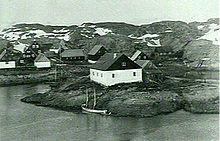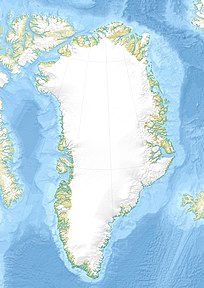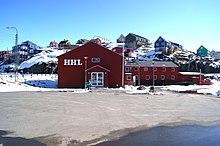Maniitsoq
| Maniitsoq (the uneven) | ||
|---|---|---|
|
Sukkertoppen (the Sugar Loaf) Manîtsoĸ |
||
| Maniitsoq (1890) | ||
| Commune | Qeqqata communia | |
| District | Maniitsoq | |
| Geographical location | 65 ° 24 '59 " N , 52 ° 53' 59" W | |
|
|
||
| Residents | 2,534 (January 1, 2020) |
|
| founding | 1781 | |
| Time zone | UTC-3 | |
Maniitsoq [ maˈniːt͡sːɔq ] (according to the old spelling Manîtsoĸ ; Danish Sukkertoppen ) is a Greenland city in the Maniitsoq district in the Qeqqata Communia .
location
Maniitsoq is located on the south coast of a larger island of the same name , which is surrounded by hundreds of smaller islands and skerries. The year-round navigable sea in front of Maniitsoq forms a bay into which the Maniitsup Sermilia flows on the one hand, but is also connected to a complex of straits and fjords further north on the other. The nearest towns are Kangaamiut, 50 km north-northwest, and Napasoq, 47 km south-southeast .
history
Traces of the Saqqaq culture dating back 4500 years can be found in the area .
Maniitsoq was founded in 1781 when the Sukkertoppen colony was moved here from Kangaamiut . The merchant Jens Larsen Smidt suggested the relocation in 1779 because, according to him, Maniitsoq was well suited for whaling. In 1780 a house was brought to Maniitsoq, but it was not built until May 1783. Anders Olsen , who once founded Sukkertoppen, was indignant about the relocation of "his colony". Inspector Bendt Olrik had a whaling facility built, but not a single whale was caught for six years, and in 1787 the facility was called for. In 1794 the apartment of the colonial administrator exploded, with assistant Immanuel Arøe being seriously injured and another colonialist dying. Another explosion occurred in the middle of the 19th century. The building was only demolished in 1907. In 1802 Maniitsoq had 330 inhabitants. In 1832 the colony already had 485 inhabitants and it was considered the best colony in South Greenland. At this time people also tried to hunt sharks. In 1855 there were only 276 inhabitants.
From 1911 Maniitsoq was the capital of the Sukkertoppen community, which still included the Qeqertaq , Ikkamiut and Kangerluarsuk residential areas .
In 1918 there were 466 people in Maniitsoq, including 13 Europeans. This made Maniitsoq the largest town in Greenland at that time. Among the residents were the colonial administrator, the doctor, a volunteer, a nurse, a helper, a foreman, a boatman, four carpenters, a blacksmith and gunsmith, a baker, a motor mechanic, two coopers, a cook, and four apprentices a midwife and, in church services, an ordained head catechist and three catechists. Among the Greenlanders were 43 hunters and 24 fishermen.
In 1918 the following public buildings were in Maniitsoq. The apartment of the colonial administrator from 1907, the apartment of the trading assistant from 1844, which was the former apartment of the colonial administrator, a cooperage and bakery from 1906, a provision house with shop from 1850, two fish houses, a bacon house from 1881, a oil distillery from 1859 Building from 1874, which served as a brewery, carpenter's workshop and forge, the doctor's apartment from 1910, the hospital from 1908, a wash house with coal room from 1910, several barrel, material and coal sheds, a powder house and a petroleum house, a goat barn and the old one Hospital as well as the church and school. The Greenlanders lived in 57 houses.
Maniitsoq was the largest town in the country until the 1940s. From 1950 to 2008 Maniitsoq was the capital of the Maniitsoq municipality . Since 2009 Maniitsoq has been the second city in the Qeqqata communia .
List of colonial employees until 1921
Colonial administrator
The following people worked as colonial administrators in the Sukkertoppen colony until 1921. The colonial administrators from the time when the colony was in Kangaamiut are also mentioned.
- 1755-1763: Anders Olsen
- 1763-1767: Hans Rasmussen Storm
- 1767–1773: Anders Olsen
- 1773–1783: Jens Larsen Smidt
- 1783–1784: Johannes Pedersen Hammer (interim)
- 1784–1787: Jørgen Christoph von Koppelow Lund
- 1787–1788: Niels Larsen Lunde
- 1788–1789: Frederik Christian Kragstedt
- 1789–1791: Michael Falck
- 1791–1794: Niels Christian Mathiesen
- 1794: Christian Friele Kahrs (interim)
- 1794–1795: Nikolaj Daniel Muus
- 1795–1799: Johan Ludvig Hilcker
- 1799-1804: Mads Hvass Mørch
- 1804–1813: Wilhelm Mathias Olrik
- 1813–1815: Gerhard Heiberg Wolff
- 1815–1816: Immanuel Arøe (interim)
- 1816–1824: Gerhard Heiberg Wolff
- 1824–1825: Carl Edvard Ernst
- 1825–1826: Peter Julius Kall
- 1826–1835: Holger Biilmann
- 1835–1836: Frederik Waldemar Arntz (interim)
- 1836–1837: Johan Peder Engholm (interim)
- 1837–1849: Holger Biilmann
- 1849–1854: Henning Bistrup
- 1854–1857: Frederik Waldemar Arntz
- 1857–1859: Henning Bistrup
- 1859–1867: J. Georg Kursch
- 1867–1868: Octavius Frederik Wilhelm Nielsen
- 1868–1870: Niels Peter Svanberg
- 1870–1873: Hans Frederik A. Hansen
- 1873–1874: Hans Nicolai Christian Lassen (interim)
- 1874–1880: Carl Emil Olfert Lytzen
- 1880–1882: Lorentz Frederik Mathiesen
- 1882–1883: Frederik Andreas Asmus Christian Valdemar Gabriel Tryde Lassen (interim)
- 1883–1885: Lorentz Frederik Mathiesen
- 1885: Jonathan Mathiesen
- 1885–1887: Peter Jürgen Petersen (interim)
- 1887–1890: Rasmus Müller
- 1890–1900: Laurits Hans Christian Bistrup
- 1900–1901: Oscar Peter Cornelius Kock (interim)
- 1901–1911: Laurits Hans Christian Bistrup
- 1911–1912: Oluf Hastrup
- 1912–1916: John Christian Gustav Baumann
- 1916–1920: Christian Sigvald Jensen Langskov
- from 1920: Nikolaj Adolf Valdemar Chemnitz
Missionaries and pastors
The Sukkertoppen colony mostly belonged to the parish of the Holsteinsborg colony . From 1902 an ordained head catechist was active as the pastor's representative in the Kolnie.
- 1757–1764: Berthel Laersen (catechist)
- 1764–1782: Berthel Laersen
- 1784-1792: Niels Hveysell
- from 1902: Elias Kristian Frederik Petersen (head catechist)
doctors
The Sukkertoppen colony was the seat of the medical district, which also included the Holsteinsborg colony. The following doctors were active in the colony.
- 1908–1909: Carl Martin Norman-Hansen (interim)
- 1909–1912: Carl Frederik Petersen
- 1913–1917: Carl Andersen
- 1917–1918: A. Møller (interim)
- from 1918: Hjalmar Mobell Borchersen
economy
In 1832 a whaling station was built in Maniitsoq and whaling formed the basis of income for the place in the first decades. After the Second World War , a fish factory was set up to process crabs and cod . There is also a shipyard in Maniitsoq . Maniitsoq is also the headquarters of the trading company KNI . From the 1980s onwards, fishing began to decline in the city. In the first half of the 2010s, consideration was given to building an aluminum smelter in Maniitsoq, which should go hand in hand with a major expansion of the city; but Alcoa announced in 2015 that it would not continue the project for economic reasons.
Infrastructure and supply
The port of Maniitsoq is in need of renovation. Originally, a new port was to be built together with the smelter. In 2000, Maniitsoq Airport opened to replace the old heliport. On the streets of Maniitsoq there is a bus line operated by the Manii Bussii transport company , which connects the main settlement areas of the place.
Nukissiorfiit operates a waterworks on a lake north of the city in Maniitsoq. Nukissiorfiit is also responsible for the power supply, which comes from a diesel power plant that went into operation in 2011. The heat is supplied via district heating , which is obtained through waste incineration and the diesel power plant. Two thirds of the buildings in Maniitsoq are connected to a sewage network. TELE Greenland is responsible for telecommunications in Maniitsoq.
Development
In Maniitsoq there is a kindergarten and an Efterskole , which has been housed in the former fishing school since 2011. In addition to a youth club, Maniitsoq also has a sports hall, a football field, an art workshop, an assembly building and the Maniitsoq Museum , which consists of colonial buildings that were moved when the fish factory was built. The old church from 1864, which was the largest stone building in the country at the time, also functions as a meeting place, while the new church is from 1981. A ski club operates a ski area around 27 km northeast on the Apussuit glacier .
Maniitsoq structure
In July 2012, an international team of researchers led by the Geological Research Institute for Denmark and Greenland (GEUS) published a report on the discovery of a circular geological structure about 100 km in diameter located around 50 km southeast of Maniitsoq, in which they contain the remains of the largest and most recent believed to have identified the oldest discovered meteorite impact crater on earth . Granite samples taken show unusual characteristics ( impactites , cones of rays ), which are attributed to the short-term, one-time effects of enormous energies, such as those released during an impact event . According to the researchers, the structure can be traced back to the impact of an approximately 30 km large asteroid in the Mesoarchean (around 3000 Ma ); The original crater is said to have been 500–600 km wide and 30 km deep than the largest known terrestrial structure of this type, the Vredefort crater in South Africa.
Trivia
- The novel Ewigkeitsfjord , written by the Danish writer Kim Leine , is set in Maniitsoq .
- Because of the large number of bridges, Maniitsoq is also known as the Venice of Greenland.
Sons and daughters
- Laurits Hans Christian Bistrup (1850–1914), Danish merchant and inspector of Greenland
- Albrecht Josefsen (1857–1921), Provincial Councilor
- Nathan Lyberth (1864–1921), National Councilor
- Albrecht Platou (1878–1948), Provincial Councilor
- Karl Rosing (1878–?), Provincial Councilor
- Karl Lyberth (1894–1977), Provincial Councilor
- Ole Petersen (1894–1979), Provincial Councilor
- Jonas Petersen (1898–?), Catechist and councilor
- Albrekt Skifte (1898–?), Provincial Councilor
- Carl Frederik Bistrup Simony (1909–1983), Danish lawyer, civil servant and compatriot of Greenland
- Lars Møller (1911–1978), catechist and councilor
- Nikolaj Rosing (1912–1976), politician, teacher, translator and writer
- Peter KS Heilmann (1916–2005), teacher and regional councilor
- Hans Egede Berthelsen (1918–?), Printer, journalist, teacher, singer and regional councilor
- Alibak Josefsen (1925–1987), fisherman and councilor
- Hans Christian Petersen (1925–2015), university rector, teacher and author
- Niels Carlo Heilmann (1927–1991), politician (Atassut)
- Robert Petersen (* 1928), Eskimologist, dialectologist, anthropologist, university professor and university rector
- Enos Lyberth (1931–2016), politician (Siumut)
- Samuel Biilmann (* 1936), pastor
- Daniel Skifte (1936–2020), politician (Atassut), teacher and skier
- Mariane Petersen (* 1937), poet and translator
- Aqissiaq Møller (1939–1997), civil servant, teacher, headmaster, poet and translator
- Bjarne Kreutzmann (* 1943), politician and police officer
- Rasmus Lyberth (* 1951), singer, songwriter and actor
- Siverth K. Heilmann (* 1953), politician (Atassut) and policeman
- Sofie Petersen (* 1955), bishop
- Mimi Karlsen (* 1957), politician (Inuit Ataqatigiit) and teacher
- Jakob Larsen (* 1974), handball player and trainer
- Angutimmarik Kreutzmann (* 1988), handball player
- Akutaaneq Kreutzmann (* 1989), handball player
Population development
Maniitsoq was the largest town in Greenland until 1940. The population reached just under 3,200 in the early 1990s. Since then, the number of inhabitants has been falling. The city has now lost a fifth of its population compared to 1991.

Web links
Individual evidence
- ↑ Map with all official place names confirmed by Oqaasileriffik , provided by Asiaq
- ↑ a b c d Maniitsoq at groenlandkreuzfahrt.de
- ^ A b c d Louis Bobé : Beskrivelse af Distrikterne i Sydgrønland: Sukkertoppen district. History. Colonies of succulent tops . In: Georg Carl Amdrup , Louis Bobé , Adolf Severin Jensen , Hans Peder Steensby (eds.): Grønland i tohundredeaaret for Hans Egedes landing (= Meddelelser om Grønland . Volume 60-61 ). tape 2 . C. A. Reitzel Boghandel, Copenhagen 1921, p. 172 f . ( Digitized in the Internet Archive ).
- ↑ a b c Ole Bendixen : Beskrivelse af Distrikterne i Sydgrønland: Sukkertoppen District. Bopladser i Sukkertoppen district. Colonies of succulent tops . In: Georg Carl Amdrup , Louis Bobé , Adolf Severin Jensen , Hans Peder Steensby (eds.): Grønland i tohundredeaaret for Hans Egedes landing (= Meddelelser om Grønland . Volume 60-61 ). tape 2 . C. A. Reitzel Boghandel, Copenhagen 1921, p. 151 ff . ( Digitized in the Internet Archive ).
- ↑ a b c d Maniitsoq in Den Store Danske
- ↑ a b c Maniitsoq at qeqqata.odeum.com
- ↑ Smelteværk af aluminum sat on standby in Sermitsiaq
- ↑ Bus timetable provided by Qeqqata Kommunia
- ^ Adam A. Garde, Iain McDonald, Brendan Dyck, Nynke Keulen: Searching for giant, ancient impact structures on Earth: The Mesoarchaean Maniitsoq structure, West Greenland . In: Earth and Planetary Science Letters . tape 337–338 , July 1, 2012, ISSN 0012-821X , p. 197-210 , doi : 10.1016 / j.epsl.2012.04.026 (abstract).
- ↑ Population of Maniitsoq 1977–2020 at bank.stat.gl





